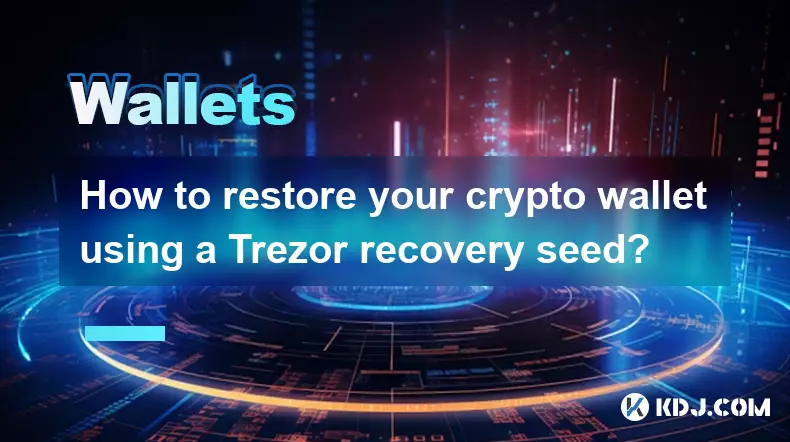-
 bitcoin
bitcoin $115849.501581 USD
-0.20% -
 ethereum
ethereum $4657.446044 USD
-1.30% -
 xrp
xrp $3.094289 USD
-0.74% -
 tether
tether $1.000313 USD
-0.03% -
 solana
solana $243.548889 USD
0.20% -
 bnb
bnb $930.722647 USD
0.20% -
 usd-coin
usd-coin $0.999696 USD
-0.01% -
 dogecoin
dogecoin $0.283551 USD
1.29% -
 tron
tron $0.349632 USD
-0.77% -
 cardano
cardano $0.915982 USD
-1.94% -
 hyperliquid
hyperliquid $54.899464 USD
-0.88% -
 chainlink
chainlink $24.718086 USD
-1.68% -
 ethena-usde
ethena-usde $1.001078 USD
-0.02% -
 sui
sui $3.756062 USD
0.14% -
 stellar
stellar $0.399024 USD
-1.87%
How to restore your crypto wallet using a Trezor recovery seed?
Your Trezor recovery seed is a master key—safeguard it offline, never share it, and use it only on genuine devices to restore full access to your crypto.
Sep 11, 2025 at 05:54 pm

Understanding the Trezor Recovery Seed
1. A Trezor recovery seed is a sequence of 12, 18, or 24 words generated during the initial setup of your Trezor hardware wallet. These words act as the master key to access all cryptocurrencies stored in the device. Without this seed, losing access to the physical device could result in permanent loss of funds.
2. The recovery seed is created using the BIP39 standard, which ensures compatibility across various wallets and platforms. It’s critical that these words are recorded exactly as displayed—spelling errors or incorrect word order will prevent successful restoration.
3. During the creation process, Trezor displays each word on its screen one at a time. Users must manually write them down on paper or store them securely using alternative offline methods. Never take screenshots, type them into online devices, or store them in cloud services.
4. The seed does not need to be memorized. Instead, it should be safeguarded in a secure physical location, such as a fireproof safe or a tamper-evident storage solution. Multiple copies can be made but must remain protected from theft and environmental damage.
5. It's important to never share your recovery seed with anyone, including Trezor support staff. Legitimate companies will never ask for it.
Preparing for Wallet Restoration
1. Before initiating restoration, ensure you have access to a genuine Trezor device. Counterfeit or compromised hardware may steal your seed during input. Always purchase directly from the official Trezor website or authorized resellers.
2. Use a clean, malware-free computer when connecting your Trezor. Malicious software can intercept data transferred over USB, even if the seed itself isn’t transmitted digitally.
3. Download and install the latest version of Trezor Suite from the official website. Avoid third-party applications or outdated versions that might contain vulnerabilities or fail to recognize your seed properly.
4. Disconnect from the internet temporarily during the seed entry phase if performing advanced security measures. While Trezor processes the seed locally, minimizing attack surface adds an extra layer of protection.
5. Have your written recovery phrase ready. Double-check that all words are legible and in the correct order before beginning the restoration process.
Step-by-Step Restoration Process
1. Connect your Trezor device to your computer via USB and power it on. If setting up a new device or wiping a used one, select “Recover wallet” from the setup menu instead of “Create new wallet.”
2. Confirm the number of words in your recovery seed when prompted. Choosing the wrong count will lead to failed restoration. Most users opt for 24 words due to higher entropy, though 12-word seeds are also valid.
3. Enter each word by selecting it from the on-screen keyboard displayed on your Trezor’s screen. The device verifies each selection locally, ensuring no external system sees the full seed.
4. After entering all words, the device checks their validity using a cryptographic checksum embedded within the BIP39 standard. If any word is incorrect, you’ll be prompted to retry.
5. Once verified, your wallet will begin syncing with the blockchain through Trezor Suite. All previously held balances across supported coins will reappear as the transaction history loads.
Frequently Asked Questions
Can I restore my Trezor seed on a different brand of hardware wallet?Yes, in most cases. Because Trezor uses the BIP39 and BIP44 standards, your seed can typically be imported into other compatible wallets like Ledger, KeepKey, or certain software wallets. However, some coin-specific implementations may vary, so always verify compatibility before transferring large amounts.
What happens if I enter the seed words in the wrong order?The wallet will either fail to generate the expected addresses or show a zero balance. Since the seed’s meaning depends entirely on word sequence, even a single transposed word results in a completely different wallet. You must re-enter the entire phrase correctly to regain access.
Is it safe to reuse a recovered wallet after restoring the seed?Yes, once restored, the wallet functions identically to the original. All private keys are regenerated deterministically from the seed. There is no reduction in security as long as the device remains uncompromised and the seed hasn’t been exposed.
Can I recover only specific cryptocurrencies from my seed?No. The recovery seed unlocks the entire wallet structure, including all accounts and coins ever generated under it. You cannot selectively restore assets; however, you can choose which coin interfaces to activate within Trezor Suite after recovery.
Disclaimer:info@kdj.com
The information provided is not trading advice. kdj.com does not assume any responsibility for any investments made based on the information provided in this article. Cryptocurrencies are highly volatile and it is highly recommended that you invest with caution after thorough research!
If you believe that the content used on this website infringes your copyright, please contact us immediately (info@kdj.com) and we will delete it promptly.
- BlockchainFX (BFX): The Crypto Super-App Set to Dominate 2025, Outshining BlockDAG and Redefining Crypto ROI
- 2025-09-15 04:25:12
- Crypto Market Catalysts & Top Trends: What's Driving the Next Wave?
- 2025-09-15 04:25:12
- Uniswap Whale Watch: UNI Consolidation and What It Means for You
- 2025-09-15 04:45:15
- Ethereum Staking and the Exit Queue: What's the Holdup?
- 2025-09-15 05:05:11
- Bitcoin, Funds, and Investments: Old Money Meets New Tech
- 2025-09-15 04:30:11
- XLM Price, XRP Remittix & Crypto Betting: What's the Smart Money Doing?
- 2025-09-15 04:45:15
Related knowledge

How to check your crypto portfolio performance in Exodus?
Sep 14,2025 at 08:36am
Accessing Your Portfolio Overview in Exodus1. Launch the Exodus application on your desktop or mobile device and enter your password to unlock your wa...

How to sell crypto from your Exodus wallet?
Sep 13,2025 at 12:01pm
Selling Crypto from Your Exodus WalletExodus is a popular non-custodial wallet that supports a wide range of cryptocurrencies. While it doesn’t allow ...

How to back up your Exodus wallet?
Sep 11,2025 at 04:19pm
Understanding Exodus Wallet Backup Basics1. Exodus is a software wallet that allows users to store, manage, and exchange various cryptocurrencies dire...

How to transfer funds from Binance to your Exodus wallet?
Sep 10,2025 at 10:19pm
Connecting Your Binance Account to Exodus Wallet1. Log in to your Binance account and navigate to the 'Wallet' section under the 'Funds' tab. Select '...

What cryptocurrencies does the Exodus wallet support?
Sep 11,2025 at 03:36pm
Overview of the Exodus WalletExodus is a user-friendly cryptocurrency wallet that supports a wide range of digital assets. Designed for both beginners...

How to export your Exodus transaction history for taxes?
Sep 12,2025 at 04:36pm
Exporting Transaction History from Exodus for Tax Reporting1. Open the Exodus wallet application on your desktop and ensure all transactions are synce...

How to check your crypto portfolio performance in Exodus?
Sep 14,2025 at 08:36am
Accessing Your Portfolio Overview in Exodus1. Launch the Exodus application on your desktop or mobile device and enter your password to unlock your wa...

How to sell crypto from your Exodus wallet?
Sep 13,2025 at 12:01pm
Selling Crypto from Your Exodus WalletExodus is a popular non-custodial wallet that supports a wide range of cryptocurrencies. While it doesn’t allow ...

How to back up your Exodus wallet?
Sep 11,2025 at 04:19pm
Understanding Exodus Wallet Backup Basics1. Exodus is a software wallet that allows users to store, manage, and exchange various cryptocurrencies dire...

How to transfer funds from Binance to your Exodus wallet?
Sep 10,2025 at 10:19pm
Connecting Your Binance Account to Exodus Wallet1. Log in to your Binance account and navigate to the 'Wallet' section under the 'Funds' tab. Select '...

What cryptocurrencies does the Exodus wallet support?
Sep 11,2025 at 03:36pm
Overview of the Exodus WalletExodus is a user-friendly cryptocurrency wallet that supports a wide range of digital assets. Designed for both beginners...

How to export your Exodus transaction history for taxes?
Sep 12,2025 at 04:36pm
Exporting Transaction History from Exodus for Tax Reporting1. Open the Exodus wallet application on your desktop and ensure all transactions are synce...
See all articles










































































